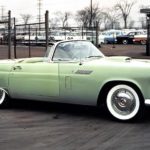All the way back in 1903, Henry Ford drove the Arrow in an effort to break the land speed record. With the help of mechanic Ed “Spider” Huff, Ford managed to hit a new record of 91.37 mph in the middle of January in Michigan. Though Ford himself didn’t enjoy racing, he did like to build cars that could compete. Racers loved Ford’s Model T for its ability to be fitted with aftermarket parts, and later the V8 became another popular choice. These early Fords were ground-breaking, setting the stage for faster cars in the future, and are vehicles only found in museums rather than at your local used Ford dealer.
Now that we have reached the age of the electric vehicle, Ford is once again pushing the boundaries with the Ford Mustang Mach E. The Mustang is a name associated with speed and power, and building a performance version as an electric GT is the bridge to a whole new future of racing potential. Ford released media tidbits about the all-electric GT achieving zero to 60 times of 3.5 seconds, a feat that is impressive until you look at some of the other powerful racing machines Ford has built over the years. We put together a list of the fastest Ford vehicles ever built, and at least one of the cars might surprise you.
#10: 2004 Ford Racing Focus RS8
Perhaps the most shocking car on this list is the Ford Focus, built by the Ford Racing Technology team in order to exhibit the capability of the “Cammer” V8 crate motors with the use of aftermarket parts. The fully aluminum DOHC V8 was bored to 5.0 liters, paired with all-wheel drive, and built out with countless upgrades to the performance so it would make 450 hp. With all the aftermarket parts, the 2004 Focus could run the quarter-mile in 12.7 seconds and shot from zero to 60 in 4.4 seconds. Motor Trend tested the Focus against a Lamborghini Gallardo of the same model year and found that the Focus could actually beat the Lambo around Willow Springs. After the Ford Racing Tech team created this ludicrous patchwork of jaw-dropping performance, Ford decided to offer a kit to rig out the Focus in case anyone else wanted to have the same fun.
#9: 1976 Kemp Mustang Cobra II Race Car
A different flavor of racing took hold of Mark Donahue and Charlie Kemp back in 1975, the kind that was a little more serious: the 24 Hours of Daytona. Originally, the plan was to race a pair of Monzas, but in the midst of building the cars, Donahue died during a test drive for the Austrian Grand Prix. Kemp decided to alter the plan and go with a Mustang instead, with Jack Roush building the Mustang to the specs drawn out by engineer Bob Riley. The build finished just under the wire, and when the Mustang went out on the course, it had never been driven before. Later, this same model underwent some adjustments to take its former 585 hp up to 635 hp, which resulted in the Cobra taking down the zero to 60 time of 3.8 seconds. Its fastest speed clocked on the course was 212 mph.
#8: 2007 Ford Mustang FR500GT
Fast forward a few decades, and the Mustang has seen numerous iterations over the years through work with famous racing teams. For the 2007 model year, Ford’s in-house racing division chose to partner with Multimatic Motorsports to create the fastest Mustang Ford had ever built at that time. Using carbon fiber and aluminum to keep the car light, the FR500GT could hit a top speed of 172 mph and clocked a zero to 60 time of 3.9 seconds. This car remains a Mustang for the record books.
#7: 2018 Ford Mustang GT with Performance Pack
Sometimes it’s the racing team that comes up with the brilliant insights for speed, and sometimes it’s the prototype team. In the case of the 2018 Mustang GT, it’s the latter, and they went hog wild with tuning up the GT to perform. Once again, aluminum plays a part in keeping the Mustang light, and then careful tuning of systems like the stability control, steering, and the MagneRide Damping with the addition of anti-roll bars makes for a powerful machine that can hit the zero to 60 mark in only 3.8 seconds, shaving off a tenth of a second from the 2007 Mustang that precedes this one on the list.
#6: 2003 Vortech Supercharged Mach 1 Mustang
Though this supercharged Mustang model may boast the same zero to 60 time as the 2018 Mustang GT at 3.8 seconds, it hits the quarter-mile at a slightly quicker tenth of a second, making an even 12 seconds. With a shaker hood, a finely-crafted suspension built by Griggs Racing, and a DOHC 4.6-liter V8, this aftermarket Mustang created a fuss when it came out. Up against the stock Mach 1 straight off the line, the Vortech beat it handily for speed. In fact, the stock Mustang zero to 60 time was a still respectable 4.7 seconds, but in racing times, it’s far in the rearview mirror.
#5: 2005 Ford GT
When chief engineer Camilo Pardo started building the 2005 GT, help arrived in the form of Carroll Shelby, the original designer of the iconic GT40. With such auspicious assistance, Pardo created a masterpiece of speed and agility that came out just in time for Ford’s 100th anniversary. The design is a modern spin-off of the GT40 with a wider stance and an additional four inches of height, though aside from a little family resemblance, the two cars are completely different builds. When it came out as a limited edition, Ford chose to add a flourish to the headlights with a “100” in the left headlight to celebrate the anniversary. Car and Driver road-tested the GT, managing a quick zero to 60 time of 3.5 seconds.
#4: 2020 Shelby GT500 Mustang
As we close in on the number one slot for Ford’s fastest cars, we finally arrive at a modern build, once again featuring a brainchild of the famous Carroll Shelby. This time the Mustang actually bears the designer’s name, which is fitting for the 760-horsepower supercharged V8 marvel that Ford called its most “power-dense” production V8 of all time. Carbon fiber, MagneRide suspension, and ingenuity all return to the creation of yet another fast road racer that can smash the quarter-mile in 11.1 seconds and leap from zero to 60 in 3.4 seconds.
#3: 2019 Ford GT Carbon Series
While a GT can be a Mustang, a Mustang is not a GT. For the 2019 GT Carbon Series, Ford builds the lightest of its GT offerings, shaving 40 pounds off the final design. Because every little ounce matters, parts of the car remained unpainted, showing off its carbon fiber construction. Thanks to its incredible speed and agility, the Carbon Series achieved zero to 60 times of 2.9 seconds, a true Le Mans-worthy achievement. This GT is considered a supercar with good reason.
#2: 2005 Hennessey Ford GT HPE850
Aftermarket parts are what make up the considerable power of the Hennessey GT that can blast from zero to 60 in a remarkable 2.7 seconds. High-strung capability comes from a 3.4-liter supercharged engine that makes 850 hp and can brandish a top speed of 225 mph. Of course, part of the packaging includes excellent airflow to keep this wildly impressive engine cool. What’s even cooler is the fact that such impressive numbers come from a vehicle more than 15 years old.
#1: 1994 Ford SVT Boss Mustang 10.0L Concept
Finally, we reach the top of the list with yet another Mustang from Ford, but this one never saw the manufacturing line. Instead, this concept car was created by taking parts from all the best aspects of performance vehicles of the past and then letting Roush bore the engine block. The Boss Mustang concept was swift enough to best a 993 Porsche 911 Turbo with its incredible zero to 60 time of 1.9 seconds and the quarter-mile of 10.5 seconds. With such impressive speed, it’s a shame Ford chose not to continue the development of this supercar, but trouble with the transmission, among other problems, pushed the project off the table. Ford chose to pursue supercharged engines instead, but we have yet to see one that beats this Boss.




